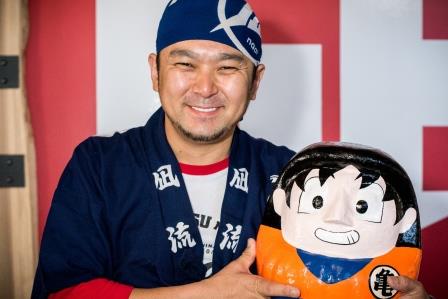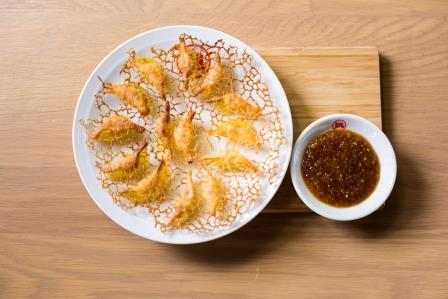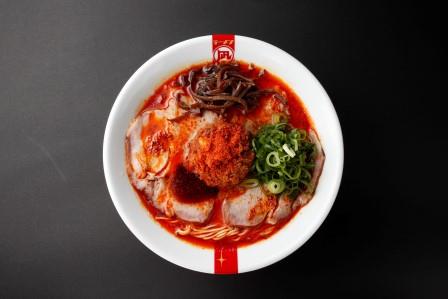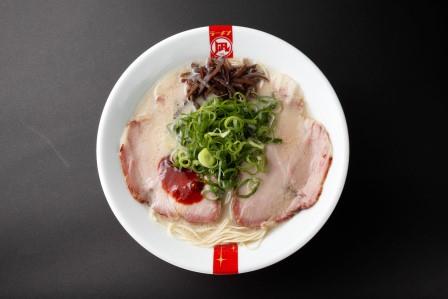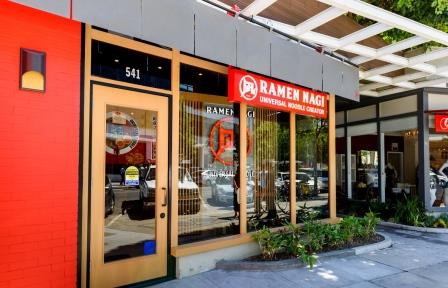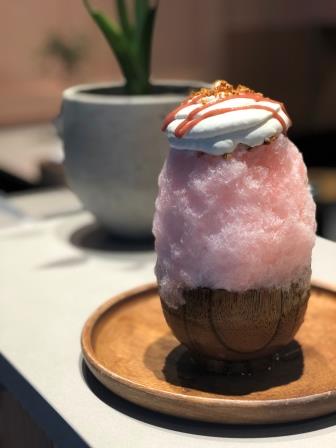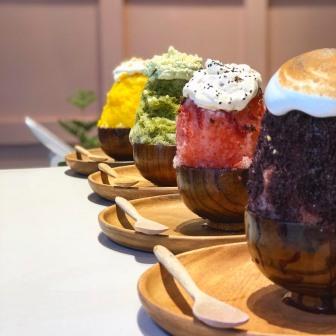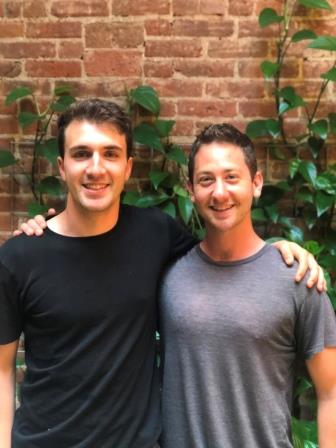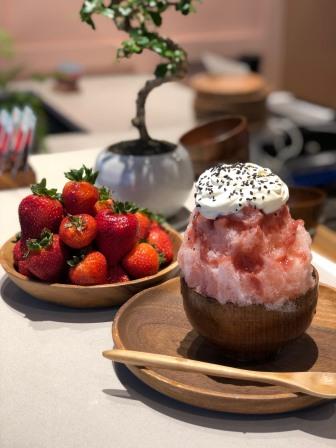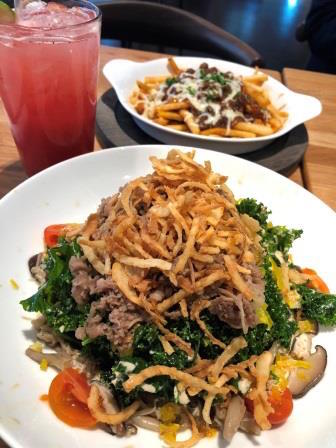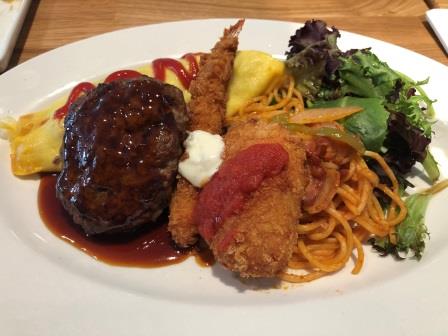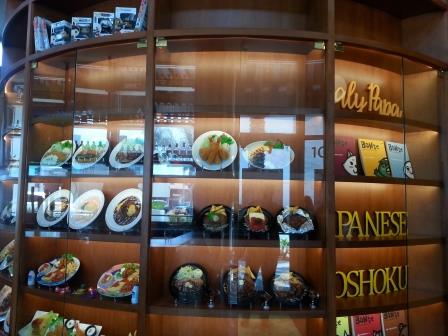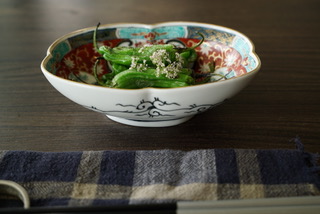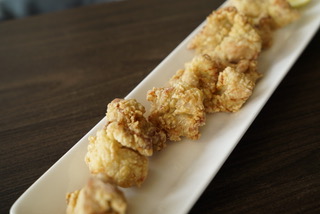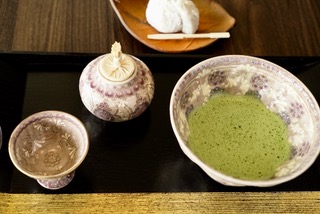A desire for spreading Japanese street foods to the US
By Aya Ota
“DokoDemo”, a restaurant which develops and serves everyday casual dishes that are so familiar to Japanese people such as yakisoba, okonomiyaki, takoyaki, etc., opened in NY, and is attracting a lot of attention.
“I would like to spread Japanese street foods throughout the US,”says Shin Takagi, the owner of the restaurant. Mr. Takagi has a unique background of working vividly as an investment banker in Tokyo and NY. While working in New York, his dream of launching a restaurant business in the US grew big, and he retired from the investment bank in 2013. Having zero experience in the food and beverage industry, he traveled all over Japan for 3 years after resigning from his previous job, studying various local street foods. Moreover, he even worked for free at some teppan-yaki restaurants to gain experience. He started to visit NY every month after the latter half of 2016, looking for the location for the restaurant, and he finally moved to the US in 2017. For the next 6 months, he did nothing but developing recipes day after day.
Then, in August of 2017, he finally opened his long-awaited first restaurant. “I chose this genre for nation-wide development in mind. “No one has yet tried to take on franchising restaurants of Japanese street foods such as yakisoba, okonomiyaki, takoyaki, etc.,” said Mr. Takagi. After the opening, he had difficulty bringing in customers.
Although the popularity of Japanese foods is growing stronger, okonomiyaki and takoyaki are not yet well recognized. For 3 months after the opening, he was wondering around the neighborhood, and talked to people on the streets who appeared to be looking for a Japanese restaurant with a cell phone in hand. He would say, “I just opened a Japanese street foods restaurant. Would you come taste some for free?” He sincerely listened to the people who came to taste the foods. “How was it?” He asks, and often times, all he gets is a simple timid comment like, “It was good.” He then started to ask people who ordered more than one menu item,; “Which one did you like?”, and he gradually became able to get more detailed comments on their 2nd and 3rd favorite dishes. Sometimes, he even tasted customers’ leftover in the trash to find out what was wrong.
Only 6 different kinds of dishes are served; “Yakisoba/Stir-Fried Ramen ($8.95), “Ramen Rice (Stir-Fried Ramen & Rice) ($9.95)”, “Fried Rice ($8.95)”, “Japanese Pizza/Okonomi- Yaki ($8.95)”, “Takoyaki (10 balls for $8.95/6 balls for $6.45), and “Cabbage & Cucumber Salad ($7.95)”. The original recipes took him a long and hard 6 months to create prior to the opening, and were satisfactory to him; however, he has remained flexible, and kept making improvements and adjustments many times along the way. After some trial-and-error period, he came up with the “customization” idea. In general, Americans prefer sweeter taste, so he thought that the sauces for yakisoba, takoyaki, and okonomiyaki would be well suited to their tastes, but they didn’t always like them. According to Mr. Takagi, for yakisoba, for instance, adding an option of choosing the flavor besides regular sauce, the dish much better received. He also made everything except takoyaki and salad customizable for the ingredients and spiciness, etc. At this point, the word, “Okonomiyaki”, is not quite recognizable, so it is presented as “Japanese Pizza”. A notable item is the “Ramen Rice (Stir-Fried Ramen & Rice)”, which cannot be found almost anywhere else. You can easily get addicted to its spicy ginger flavor, and the unique combination of ramen and rice has gotten people’s attention, and the number of returning customers is growing.
“I’d like to open the second restaurant during the next year”, says Mr. Takagi. His ambition is to have 5 to 10 restaurants in Manhattan first as the base of the nationwide development, and then go to other states. In order to achieve that, he thinks that the operation has to become more efficient. Presently, it takes 10 to 15 minutes to serve after receiving orders. He has been going through many trial-anderror attempts to minimize the time to serve. He also aggressively gets into taking online orders for takeout, and deliveries.
The name, “DokoDemo”, implies his wish to make his restaurant’s street foods available everywhere in the US. I would like to look forward to the day I can see it everywhere in the US in the next few years.
日本のストリートフードを全米に広げたい
焼きそば、お好み焼き、たこ焼き…日本人にはおなじみの“ 粉もん” を専門に展開する店『DokoDemo』が登場し、注目されている。
「日本のストリートフードを全米に広げたい」と語るのは同店オーナー、高木伸之輔氏。高木氏は、東京とニューヨークで、証券マンとして活躍したという異色のキャリアを持つ。ニューヨーク滞在中に「米国で飲食業を起業したい」という夢が膨らみ、2013 年に退社。飲食業界での経験が全くない高木氏は、退職後3 年間、日本全国を回り各地のストリートフードを研究した。さらに、いくつかの鉄板焼き店では、無給で働き経験を積んだ。2016 年後半からは、毎月ニューヨークに通い物件を探し、いよいよ2017 年に再渡米。その後半年間は、来る日も来る日もレシピ開発に没頭した。
そして2017年8月、待望の1号店を開店。「全米展開を考えて、このジャンルを選択した。日本のストリートフード、“ 粉もん” をチェーン店として手がけている人は誰もいなかった」と同氏。開店後、苦労したのは集客だ。日本食人気は伸びているとは言え、お好み焼きやたこ焼きの認知度は、まだ高いとは言えない。開店後3 カ月間、同氏は店の近隣を歩き回り、携帯を片手に日本食店を探しているような人に「日本のストリートフード店を開店したのだけど、無料でいいから食べに来てほしい」と直接声をかけた。そして、実際に食べてくれた顧客の声に真摯に耳を傾けた。「どうだった?」と聞いても、遠慮気味に「美味しかった」というフィードバックしかないことも多い。そこで、複数種類のメニューを注文したグループ顧客に「どれがよかった?」と聞くようにすると、2 番目・3 番目によかったメニューに対する具体的なコメントが得られるようになってきた。時には、ゴミ箱の残飯を食べ、何がよくなかったのか研究することもあった。
同店のメニューは6種類のみ、「焼きそば」($8.95)、「そばめし」($9.95)、「炒飯」($8.95)、「お好み焼き」($8.95)、「たこ焼き」(10 balls-$8.95/ 6 balls-$6.45)、「キャベツとキュウリのサラダ) 」($7.95)。開店前に半年の時間を費やし、自身が納得いくまで創り上げたレシピだったが、柔軟な姿勢で、幾度となく改良や調整を重ねている。試行錯誤の過程で生まれたのは“ カスタマイズ” というアイデア。
一般的に米国人は甘めの味付けを好むので、焼きそば・たこ焼き・お好み焼きに使われるソース味は誰もが好きだろう思われたがそうではなかった。焼きそばでは、ソース味以外にも醤油、柚、豚骨味のバリエーションを増やし、顧客が選べるようにした結果、好評を博しているという。たこ焼きとサラダ以外は、具材や辛さなどを選べるようにした。
また「お好み焼き」という名称はまだ理解されにくいため、現時点では「Japanese Pizza」という名称を前面に打ち出している。特に注目は、他店ではほとんど見かけない「そばめし」だ。ピリッとしたショウガ味がやみつきになる味で、ラーメンとライスというユニークな組み合わせも興味を引き、リピーターも増えている。
「来年中には2店舗目を開店したい」と語る高木氏。全米展開に向けて、まずはマンハッタンに5 〜10 店舗展開し、その後、他州へも拡大していきたいという野望がある。そのためには、オペレーションの効率化を図る必要があると考えている。注文を受けてから作るため、10 〜15 分程度の待ち時間が生じるが、極力短縮できるように試行錯誤を重ねている。ネット注文でのテイクアウトやデリバリーにも積極的に取り組んでいる。
『DokoDemo』という店名には、いずれ全米の“ どこでも” 同店のストリートフードが食べられるようになってほしい…という想いが込められている。数年後には全米で見られる日を期待したい。
DokoDemo
89 E 4th St.
NY 10003
(917) 261-5228
https://www.dokodemonyc.com/
Mon.-Sat. 11:30am-10:30 pm
Sun. 12:00 pm-9:30 pm
“DokoDemo”, a restaurant which develops and serves everyday casual dishes that are so familiar to Japanese people such as yakisoba, okonomiyaki, takoyaki, etc., opened in NY, and is attracting a lot of attention.
“I would like to spread Japanese street foods throughout the US,”says Shin Takagi, the owner of the restaurant. Mr. Takagi has a unique background of working vividly as an investment banker in Tokyo and NY. While working in New York, his dream of launching a restaurant business in the US grew big, and he retired from the investment bank in 2013. Having zero experience in the food and beverage industry, he traveled all over Japan for 3 years after resigning from his previous job, studying various local street foods. Moreover, he even worked for free at some teppan-yaki restaurants to gain experience. He started to visit NY every month after the latter half of 2016, looking for the location for the restaurant, and he finally moved to the US in 2017. For the next 6 months, he did nothing but developing recipes day after day.
Then, in August of 2017, he finally opened his long-awaited first restaurant. “I chose this genre for nation-wide development in mind. “No one has yet tried to take on franchising restaurants of Japanese street foods such as yakisoba, okonomiyaki, takoyaki, etc.,” said Mr. Takagi. After the opening, he had difficulty bringing in customers.
Although the popularity of Japanese foods is growing stronger, okonomiyaki and takoyaki are not yet well recognized. For 3 months after the opening, he was wondering around the neighborhood, and talked to people on the streets who appeared to be looking for a Japanese restaurant with a cell phone in hand. He would say, “I just opened a Japanese street foods restaurant. Would you come taste some for free?” He sincerely listened to the people who came to taste the foods. “How was it?” He asks, and often times, all he gets is a simple timid comment like, “It was good.” He then started to ask people who ordered more than one menu item,; “Which one did you like?”, and he gradually became able to get more detailed comments on their 2nd and 3rd favorite dishes. Sometimes, he even tasted customers’ leftover in the trash to find out what was wrong.
Only 6 different kinds of dishes are served; “Yakisoba/Stir-Fried Ramen ($8.95), “Ramen Rice (Stir-Fried Ramen & Rice) ($9.95)”, “Fried Rice ($8.95)”, “Japanese Pizza/Okonomi- Yaki ($8.95)”, “Takoyaki (10 balls for $8.95/6 balls for $6.45), and “Cabbage & Cucumber Salad ($7.95)”. The original recipes took him a long and hard 6 months to create prior to the opening, and were satisfactory to him; however, he has remained flexible, and kept making improvements and adjustments many times along the way. After some trial-and-error period, he came up with the “customization” idea. In general, Americans prefer sweeter taste, so he thought that the sauces for yakisoba, takoyaki, and okonomiyaki would be well suited to their tastes, but they didn’t always like them. According to Mr. Takagi, for yakisoba, for instance, adding an option of choosing the flavor besides regular sauce, the dish much better received. He also made everything except takoyaki and salad customizable for the ingredients and spiciness, etc. At this point, the word, “Okonomiyaki”, is not quite recognizable, so it is presented as “Japanese Pizza”. A notable item is the “Ramen Rice (Stir-Fried Ramen & Rice)”, which cannot be found almost anywhere else. You can easily get addicted to its spicy ginger flavor, and the unique combination of ramen and rice has gotten people’s attention, and the number of returning customers is growing.
“I’d like to open the second restaurant during the next year”, says Mr. Takagi. His ambition is to have 5 to 10 restaurants in Manhattan first as the base of the nationwide development, and then go to other states. In order to achieve that, he thinks that the operation has to become more efficient. Presently, it takes 10 to 15 minutes to serve after receiving orders. He has been going through many trial-anderror attempts to minimize the time to serve. He also aggressively gets into taking online orders for takeout, and deliveries.
The name, “DokoDemo”, implies his wish to make his restaurant’s street foods available everywhere in the US. I would like to look forward to the day I can see it everywhere in the US in the next few years.
日本のストリートフードを全米に広げたい
焼きそば、お好み焼き、たこ焼き…日本人にはおなじみの“ 粉もん” を専門に展開する店『DokoDemo』が登場し、注目されている。
「日本のストリートフードを全米に広げたい」と語るのは同店オーナー、高木伸之輔氏。高木氏は、東京とニューヨークで、証券マンとして活躍したという異色のキャリアを持つ。ニューヨーク滞在中に「米国で飲食業を起業したい」という夢が膨らみ、2013 年に退社。飲食業界での経験が全くない高木氏は、退職後3 年間、日本全国を回り各地のストリートフードを研究した。さらに、いくつかの鉄板焼き店では、無給で働き経験を積んだ。2016 年後半からは、毎月ニューヨークに通い物件を探し、いよいよ2017 年に再渡米。その後半年間は、来る日も来る日もレシピ開発に没頭した。
そして2017年8月、待望の1号店を開店。「全米展開を考えて、このジャンルを選択した。日本のストリートフード、“ 粉もん” をチェーン店として手がけている人は誰もいなかった」と同氏。開店後、苦労したのは集客だ。日本食人気は伸びているとは言え、お好み焼きやたこ焼きの認知度は、まだ高いとは言えない。開店後3 カ月間、同氏は店の近隣を歩き回り、携帯を片手に日本食店を探しているような人に「日本のストリートフード店を開店したのだけど、無料でいいから食べに来てほしい」と直接声をかけた。そして、実際に食べてくれた顧客の声に真摯に耳を傾けた。「どうだった?」と聞いても、遠慮気味に「美味しかった」というフィードバックしかないことも多い。そこで、複数種類のメニューを注文したグループ顧客に「どれがよかった?」と聞くようにすると、2 番目・3 番目によかったメニューに対する具体的なコメントが得られるようになってきた。時には、ゴミ箱の残飯を食べ、何がよくなかったのか研究することもあった。
同店のメニューは6種類のみ、「焼きそば」($8.95)、「そばめし」($9.95)、「炒飯」($8.95)、「お好み焼き」($8.95)、「たこ焼き」(10 balls-$8.95/ 6 balls-$6.45)、「キャベツとキュウリのサラダ) 」($7.95)。開店前に半年の時間を費やし、自身が納得いくまで創り上げたレシピだったが、柔軟な姿勢で、幾度となく改良や調整を重ねている。試行錯誤の過程で生まれたのは“ カスタマイズ” というアイデア。
一般的に米国人は甘めの味付けを好むので、焼きそば・たこ焼き・お好み焼きに使われるソース味は誰もが好きだろう思われたがそうではなかった。焼きそばでは、ソース味以外にも醤油、柚、豚骨味のバリエーションを増やし、顧客が選べるようにした結果、好評を博しているという。たこ焼きとサラダ以外は、具材や辛さなどを選べるようにした。
また「お好み焼き」という名称はまだ理解されにくいため、現時点では「Japanese Pizza」という名称を前面に打ち出している。特に注目は、他店ではほとんど見かけない「そばめし」だ。ピリッとしたショウガ味がやみつきになる味で、ラーメンとライスというユニークな組み合わせも興味を引き、リピーターも増えている。
「来年中には2店舗目を開店したい」と語る高木氏。全米展開に向けて、まずはマンハッタンに5 〜10 店舗展開し、その後、他州へも拡大していきたいという野望がある。そのためには、オペレーションの効率化を図る必要があると考えている。注文を受けてから作るため、10 〜15 分程度の待ち時間が生じるが、極力短縮できるように試行錯誤を重ねている。ネット注文でのテイクアウトやデリバリーにも積極的に取り組んでいる。
『DokoDemo』という店名には、いずれ全米の“ どこでも” 同店のストリートフードが食べられるようになってほしい…という想いが込められている。数年後には全米で見られる日を期待したい。
DokoDemo
89 E 4th St.
NY 10003
(917) 261-5228
https://www.dokodemonyc.com/
Mon.-Sat. 11:30am-10:30 pm
Sun. 12:00 pm-9:30 pm






